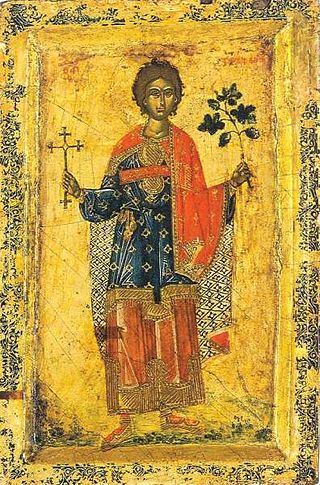
In Christian belief, a saint is a person who is recognized as having an exceptional degree of holiness, likeness, or closeness to God. However, the use of the term saint depends on the context and denomination. In Catholic, Eastern Orthodox, Anglican, Oriental Orthodox, and Lutheran doctrine, all of their faithful deceased in Heaven are considered to be saints, but a selected few are considered worthy of greater honor or emulation. Official ecclesiastical recognition, and veneration, is conferred on some denominational saints through the process of canonization in the Catholic Church or glorification in the Eastern Orthodox Church after their approval. In many Protestant denominations saint refers broadly to any holy Christian, without special recognition or selection.

A patron saint, patroness saint, patron hallow or heavenly protector is a saint who in Catholicism, Lutheranism, Anglicanism, Eastern Orthodoxy or Oriental Orthodoxy is regarded as the heavenly advocate of a nation, place, craft, activity, class, clan, family, or person.

Veneration, or veneration of saints, is the act of honoring a saint, a person who has been identified as having a high degree of sanctity or holiness. Angels are shown similar veneration in many religions. Veneration of saints is practiced, formally or informally, by adherents of some branches of all major religions, including Christianity, Judaism, Hinduism, Islam, Buddhism and Jainism.

Religious images in Christian theology have a role within the liturgical and devotional life of adherents of certain Christian denominations. The use of religious images has often been a contentious issue in Christian history. Concern over idolatry is the driving force behind the various traditions of aniconism in Christianity.

Cosmas and Damian were two Arab physicians and early Christian martyrs. They practised their profession in the seaport of Aegeae, then in the Roman province of Cilicia.

Saint Pantaleon, counted in Western Christianity as among the Fourteen Holy Helpers of the Late Middle Ages, and in Eastern Christianity as one of the Holy Unmercenary Healers, was a martyr of Nicomedia in Bithynia during the Diocletianic Persecution of 305 AD.

January 30 - Eastern Orthodox liturgical calendar - February 1

Saint Tryphon of Campsada was a 3rd-century Christian saint. He is venerated by the Roman Catholic and Eastern Orthodox churches as a great martyr and holy unmercenary.

Fabiola was a physician and Roman matron of rank of the company of noble Roman women who, under the influence of the Church Father Jerome, gave up all earthly pleasures and devoted herself to the practice of Christian asceticism and charitable work. She is venerated as a saint in the Eastern Orthodox Church and Roman Catholic church, being commemorated on 27 December.

Saints Cyrus and John are venerated as martyrs. They are especially venerated by the Coptic Church and surnamed Wonderworking Unmercenaries because they healed the sick free of charge.

Saint Diomedes of Tarsus (Diomede) is venerated as a Greek Christian saint and martyr, one of the Holy Unmercenaries.
Sampson the Hospitable was a citizen of Constantinople who devoted his time to serving the poor of the city.

Holy Unmercenaries is an epithet applied to a number of Christian saints who did not accept payment for good deeds. These include Christian healers or physicians who, in conspicuous opposition to medical practice of the day, tended to the sick, free of charge.

Hermione of Ephesus is a 2nd-century saint and martyr venerated by the Eastern Orthodox Church and Roman Catholic Church. She was well known as a "great healer" and founded the first Christian hospital in Ephesus.

October 16 - Eastern Orthodox liturgical calendar - October 18

Joannicius the Great was a Byzantine Christian saint, sage, theologian and prophet. Well known for his devoted asceticism and defense of icon veneration, Joannicius spent the majority of his life as a hermit on Mysian Olympus, near what is today Bursa, Turkey. Joannicius lived during the reign of Emperor Theophilos, a noted iconoclast, which contrasted with Joannicius's embrace of icon veneration. Icon veneration was later restored to the Byzantine Empire under the reign of Empress Theodora, a move that some devotees ascribe to Joannicius's influence and prophecies. Joannicius served in the Byzantine army in his early years before devoting his life to ascetic study and monastic contemplation. He is venerated with a feast day on November 4 in the Eastern Orthodox Church and Roman Catholic Church.

Christina, born Yazdoi, was a Sasanian Persian noblewoman and Christian venerated after her death as a virgin martyr.

October 10 - Eastern Orthodox liturgical calendar - October 12

The Catholic Church is the largest non-government provider of health care services in the world. It has around 18,000 clinics, 16,000 homes for the elderly and those with special needs, and 5,500 hospitals, with 65 percent of them located in developing countries. In 2010, the Church's Pontifical Council for the Pastoral Care of Health Care Workers said that the Church manages 26% of the world's health care facilities. The Church's involvement in health care has ancient origins.
Pelagia the Virgin, also known as Pelagia of Antioch, was a Christian saint and virgin martyr who leapt to her death during the Diocletianic Persecution in refusal to offer a public sacrifice to the pagan gods by Roman soldiers, or to do "something unspeakable ", typically inferred as the Roman soldiers attempting to rape her. She is venerated as a saint in the Eastern Orthodox Church and Roman Catholic Church.















